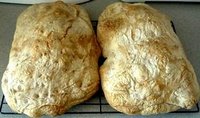

 Dear readers, fear not! I have not forgotten my New Year’s resolution to bake more bread. And since I am on spring break and have the luxury of free time at my disposal, I thought I’d try something challenging. No, no, not the laminated doughs yet! I will get there…one day! But I was reading through the wonderful Cook’s Illustrated message boards, and there was a brave fellow named Tim who decided to cook his way through the entire volume of The Bread Baker’s Apprentice (in a similar vein as the Julie/Julia Project). It makes for fascinating reading if you like to bake, and you’ll also learn a lot vicariously through his experiences with the recipes. One that he was less than impressed by, though, was their ciabatta. So on the recommendation of another wise and helpful baker named Amy, he decided to try Craig Ponsford’s ciabatta from Maggie Glezer’s Artisan Baking Across America. Both Tim and Amy highly praised their resulting loaves, so I thought I’d give it a shot myself! Well, as you can see from the pictures, I don’t think I did too bad of a job for my first attempt! It’s really an interesting process. It starts with a biga, a type of starter that uses mostly wild yeasts to develop very slowly (it took two days in my cold house!). Then you mix the biga with more flour, yeast, salt, and so much water that the resulting dough is really more aptly described as a batter. And as it proofs, you stop it every twenty minutes, pour it out onto the bench, carefully stretch it out to approximately double its size, and do a very gentle turn in lots of flour before scooping it back into the bowl and letting it rise for another twenty minutes. You repeat this four times before leaving it to proof the rest of the way. It’s very cool…you feel like you’re working a cloud of dough! And it is surprising how it comes together after all four turns. In fact, you work the dough gently but so much and so often, it’s amazing to me that it doesn’t come out as hard as a rock. But instead, the resulting ciabatte should be full of the most tantalizing holes—the swiss cheese of breads!
Dear readers, fear not! I have not forgotten my New Year’s resolution to bake more bread. And since I am on spring break and have the luxury of free time at my disposal, I thought I’d try something challenging. No, no, not the laminated doughs yet! I will get there…one day! But I was reading through the wonderful Cook’s Illustrated message boards, and there was a brave fellow named Tim who decided to cook his way through the entire volume of The Bread Baker’s Apprentice (in a similar vein as the Julie/Julia Project). It makes for fascinating reading if you like to bake, and you’ll also learn a lot vicariously through his experiences with the recipes. One that he was less than impressed by, though, was their ciabatta. So on the recommendation of another wise and helpful baker named Amy, he decided to try Craig Ponsford’s ciabatta from Maggie Glezer’s Artisan Baking Across America. Both Tim and Amy highly praised their resulting loaves, so I thought I’d give it a shot myself! Well, as you can see from the pictures, I don’t think I did too bad of a job for my first attempt! It’s really an interesting process. It starts with a biga, a type of starter that uses mostly wild yeasts to develop very slowly (it took two days in my cold house!). Then you mix the biga with more flour, yeast, salt, and so much water that the resulting dough is really more aptly described as a batter. And as it proofs, you stop it every twenty minutes, pour it out onto the bench, carefully stretch it out to approximately double its size, and do a very gentle turn in lots of flour before scooping it back into the bowl and letting it rise for another twenty minutes. You repeat this four times before leaving it to proof the rest of the way. It’s very cool…you feel like you’re working a cloud of dough! And it is surprising how it comes together after all four turns. In fact, you work the dough gently but so much and so often, it’s amazing to me that it doesn’t come out as hard as a rock. But instead, the resulting ciabatte should be full of the most tantalizing holes—the swiss cheese of breads!CRAIG PONSFORD'S CIABATTA
Biga:
1/2 teaspoon instant yeast
1 cup warm water (110-115 degrees)
1 1/3 cups bread flour
2/3 cups all-purpose flour
2 tablespoons whole wheat flour
2 tablespoons rye flour
3/4 cups water
Sprinkle the yeast over the warm water, stir, and let it stand for 5-10 minutes. Mix the flours in the bowl of a stand mixer. Measure 1/2 teaspoon of the yeasted water into the flour mixture (throw the rest away—this is only to be able to measure 1/384 teaspoon of yeast). Then add the 3/4 cup water, chilled in the summer, warm in the winter. This dough will be very firm and resistant to kneading, but persevere! Add an extra tablespoon or two of water only if absolutely necessary. Place into an oiled container, cover and ferment overnight (18–24 hours) at room temperature. (Don’t be alarmed if it does nothing for at least ten hours. This is as it should be. It will eventually triple in volume and then flatten out, appearing to have the texture of lumpy oatmeal.)
Dough:
2 cups plus 3 tablespoons all-purpose flour
1 teaspoon instant yeast
2 3/4 teaspoons salt
1 1/2 cups lukewarm water
fermented biga
Place all ingredients into a mixing bowl fitted with a paddle or dough hook. Mix on low speed until a rough dough is formed. Increase speed to medium and continue to work the dough until it is fairly smooth, about 5 minutes. (This is a very soft dough—add extra water if it is too firm.)
Place the dough into an oiled container large enough for the dough to double in bulk. Cover and ferment for 20 minutes. Scrape the dough out onto a well-floured bench, carefully stretch or press the dough out to double its size, and do a gentle turn by the folding method. Rest for another 20 minutes and repeat. You will do a turn at 20, 40, 60 and 80 minutes, and then let the dough finish proofing for another 70-100 minutes (a total proofing time, with turns, of 2 1/2 to 3 hours). You will be surprised at how much the dough firms up during this process!
Heavily flour a couche or tea towels (I used one flour sack towel for both loaves). Flour the top of the dough and the work surface and turn the dough out. With a metal scraper, cut the dough approximately in half. Gently shape and stretch into rectangles, then loosely fold into thirds like a letter. Place ciabatte seam-side down on the couche or towels, sprinkle the tops with more flour and loosely cover. Let them proof until they are very soft and well-expanded, and barely spring back when gently pressed, about 45 minutes.
After shaping the dough, arrange a rack on the second-to-top shelf in the oven and place a baking stone on it (unglazed ceramic tiles work great, too!). Preheat the oven to 450 degrees. When ciabatte are ready to bake, place a piece of parchment paper on a peel. Carefully flip the loaves onto the peel, seam side up, and stretch them very gently to make them rectangular. Dimple the dough all over with your fingertips, pressing all the way down to the paper (don’t worry—the bread will recover in the oven!). Slide the loaves on the paper onto the baking stone. Bake them until very dark brown, 35-40 minutes, rotating halfway through the bake time. Let cool on a rack.
*For step-by-step pictures of the whole process, check out Lisa's blog.
Now that you have produced two gorgeous ciabatte, what will you do with them? Well, I have two suggestions. First of all, you might consider making my favorite sandwich in the world, what we refer to around my house as simply “The Italian Sandwich.” However, I visited New Orleans for the first time about four years ago, and discovered that my special sandwich was very similar to a muffaletta. Who knew? Whatever you call it, here is the methodology. Before you construct the sandwich (hours or even the day before is preferred), combine sliced mushrooms, olives, and roasted red peppers in a container. Add a clove or two of minced garlic, and cover with half oil and half vinegar, enough to cover the veggies. Refrigerate the mixture and give it time to marinate. Later, slice your ciabatta loaf in half and pile on hot cappicola, mortadella, Genoa salami, and provolone and/or mozzarella cheese. Spoon on a thick layer of the marinated veggie relish, and top with the other half of the bread. Press the sandwich together a bit, and either heat it in the oven for a few minutes or just nuke it for 30 seconds until everything is warmed through and delightfully juicy! Heaven!
You still have another loaf of ciabatta to contend with…what now? Ok, here’s another idea, similar feeling, different form. How about a wonderful panzanella, a Tuscan bread salad? I had to take something to a potluck tonight, and this is what I came up with. I cut the ciabatta into cubes, and fried them in olive oil (and a little of the bacon drippings leftover from breakfast) until they were golden brown and crispy, then set them aside. In another large bowl, I combined:
chopped tomatoes (2-4, depending on size—or you could use something like Muir Glen’s organic diced tomatoes in the winter)
1 red onion, very thinly sliced
1 can of olives, sliced
1 can of cannellini beans, drained
2 roasted red peppers (from a jar), sliced
2 cubes or about 4 tablespoons of pesto (because I didn’t have any fresh basil)
1/4-1/2 cup vinaigrette, plus a few tablespoons of balsamic vinegar
2 cloves of minced garlic
salt and pepper to taste
Chopped cucumber is also traditional, but I didn’t have one on hand. I did add some salami (8 slices) and pepperoni (16 slices), very thinly sliced—though cubed would be preferable. I let this mixture marinate for a couple of hours in the refrigerator. Right before the party, I added the ciabatta croutons and about 2 cups of cubed mozzarella, and stirred everything together. It was delicious, if I do say so myself! And even though many traditional recipes call for soaking stale bread with water before tearing it into chunks for the salad, I liked how my version stayed crunchy and was not soggy. But see what you think. Obviously, you can riff on this dish, adding things you like, and leaving out the things you don’t.
Whatever you choose to do with it, try your hand at making the ciabatta. It's fun!







